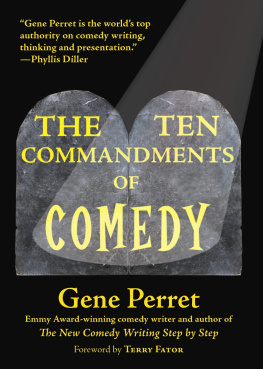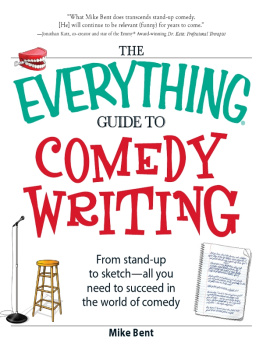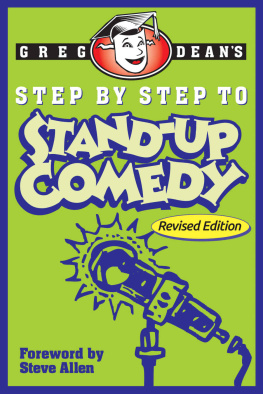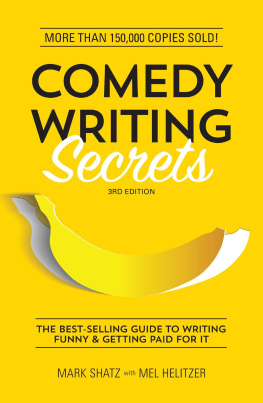
Copyright 2007 by Gene Perret
All rights reserved.
Printed in the United States of America.
Published by
Quill Driver Books/Word Dancer Press, Inc.,
1254 Commerce Ave, Sanger, CA 93657
559-876-2170 / 800-497-4909
QuillDriverBooks.com
Word Dancer Press books may be purchased for educational, fund-raising, business or promotional use. Please contact Special Markets, Quill Driver Books/Word Dancer Press, Inc. at the above address or phone numbers.
Quill Driver Books/Word Dancer Press Project Cadre: P.J. Dempsey, Doris Hall, Stephen Blake Mettee, Carlos Olivas
First Printing
ISBN 1-884995-66-1 978-1885956-66-9
To order a copy of this book, please call
1-800-497-4909.
Library of congress cataloging-in-Publication Data
Perret, Gene.
The new comedy writing step by step : revised and updated with words of instruction, encouragement, and inspiration from legends of the comedy profession / by Gene Perret.
p. cm.
ISBN 1-884956-66-1
1. Wit and humorAuthorship. I. Title.
PN6149.A88P47 2007
808.7dc22
2007009901
In memory of Bob Hope
My inspiration
My mentor
My friend
Contents
Foreword to the New Revised Edition
By Joe Medeiros
Foreword to the First Edition
By Carol Burnett
Introduction
Why an Update?
Working in a universally practiced artthe little matter of disciplining your wit, then refining your basic comedy skillswhy beginning writers are afraidthe Im not a joke writer syndromehow would-be writers defeat themselves before they startlearn how to play the percentages.
You arent born a comedy writeryou have to learn everything somehowinexperienced writing isnt bad writingwhy only you can teach yourselfwater knowledge and wine knowledge.
Analyzing comedy: the dissected frog analogypreparation and practice (and practice and practice)defining a sense of humorthe mental process of joke writingwhat most jokes aregoing beyond the obvious why anyone can write a jokeand why a writer cant depend on coincidence.
Humor and the quality of lifewhen the reward is in the doing challenge, entertainment, stimulationand you cant top it for convenience comedy as a group effortthe pleasures of personalizing humorand tangible products to boot.
Doing it for money: one of the greatest inspirationshow you can fill the demand for local colorthe most likelyand least likelymarketsselling to the subculturehow to determine what to charge.
Moving into comedy: the door isnt wide open, but is ajarthe luck factorinsatiable markets: why theyre crying for comedyhow to begin in your home town converting potential into fulfillmenthow to build small successes into larger ones.
The basic building block of humorstandup routines: a superb apprenticeshipthe best way to learnthe next best wayhow to gain confidencewhy you should stick to a quota (and why thats the soundest advice anyone will ever give you)exposing yourself to other comicsdiscovering what worksand what doesnt.
The three paramount comedy skillsmental sleight-of-hand: why visualization is so importanthow to take advantage of thinking patternsovercoming the tendency to quit too soonavoiding the obvious Gene Perrets Patented Comedy Exercises.
Showing off your materialenhancing individual jokesthe peaks and valleys principlethe steps to building and sustaining laughterthe most efficient way to set up jokeshow to prepare and write more materialdiversifying your stylewhy monologues aid sales.
The groundwork of comedy writingwhy you should write out preparatory workwhat productivity results fromthe all-important choice: finding a topichow to free-associateorganizing comedy ideas and channeling your thinkingthe secret of subtopics.
The benefits of keeping a tallythe starting point: having something to sayprompting the punch linehow to ask the right questions exaggeration and distortion: allowing your mind to playexploiting clichs for fun and profitgetting em wholesale: formula jokes.
How to determine a logical progressiona step-by-step guide to arranging gags and smoothing the edgeswhat the best transitions arethe importance of flow and the final polishmaking the audience thinkbut not for too longthe most common weaknessesand how to cure them.
How to draw out and intensify humormaking the audience identify with a truthrelaxing tension: how to get a surefire laughthe value of shock valueattacking authorityhow far is too far.
Why the audience is supreme (or, why you have no choice but to please them)making people laugh: the comics partnershiphow to investigate the local angletips on how to slant material, manipulate jokesand maintain impartialitywhy youd better make sure they understand you.
Ideas: you can never have too manyor remember them allwhy you should keep a notebookthe categories that countnotebook hints from the proskeeping topical comedy really fresheasier, faster, and better writing.
How to construct a sketchthe whys and wherefores of programming and directing craziness the Uh-oh Factorcreatingand sustainingcomplicationgenerating the ending: theres only oneand it had better workwhere to get ideas.
The story conference: pitching your ideaswriting spec scriptsavoiding taboos and boo-booshow to study the shows you write forwriting for characters in believable situationsguidelines to dialogue writingformulating sitcom jokeswhy you must map out your storythe way things happen in television: an insiders insight.
Why breaks are overrated perfecting your skills nowhow to go about being goodconvincing others youre goodthe Send the Limo syndromeexpecting rejectionwhy you have to be better than the established talentfiguring out what youre worthand what experience is worth to you.
Trial and errorhow to research the businessthe importance of dialogue: letter-writinghow to make contactsnetworkinghow much help is too much to askovercoming fear of rejectionenduring setbacks.
The one way to get samples of your workwhat to put in your portfolioknowing what a comic facesdelivering your own materialand how it benefits your writing tips on overcoming writers blockwhy you should save your workhow to reuse your material.
Discipline, discipline, disciplineputting the product on papermental games to get you through an assignmentoutlining and setting goalshow to avoid getting trapped in preparationdeadlines and being nice to yourself.
Concentrating on the positiveworking for freesidestepping disappointmentthe easiest markets to begin withthe morale boost of a salehow to contact comicslocal and nationalhow to submit television materialusing the proper script formatswhy its important to market yourself along with your work.
Those who are serious about a writing career have this question lurking in the back of their mindsthe answer to it is practical and realisticits also easy and quite possible.
Foreword
to the New Revised Edition
W hen Gene Perret asked me to write a foreword to this new version of his book, he said in his quipping, good-natured way, Make me look more intelligent and powerful than I am.
To me, Genes credibility doesnt need to be artificially inflated. I can say unequivocally that if I hadnt benefited from Gene Perrets advice and comedy writing knowledge, today I wouldnt be the head writer of The Tonight Show with Jay Leno, TVs number one late night talk show.
I can trace the steps that took me here from January 1983. I was working as a copywriter in a suburban Philadelphia ad agency. During one lunch hour, I went to a bookstore in a local mall and stumbled upon Genes book,
Next page










